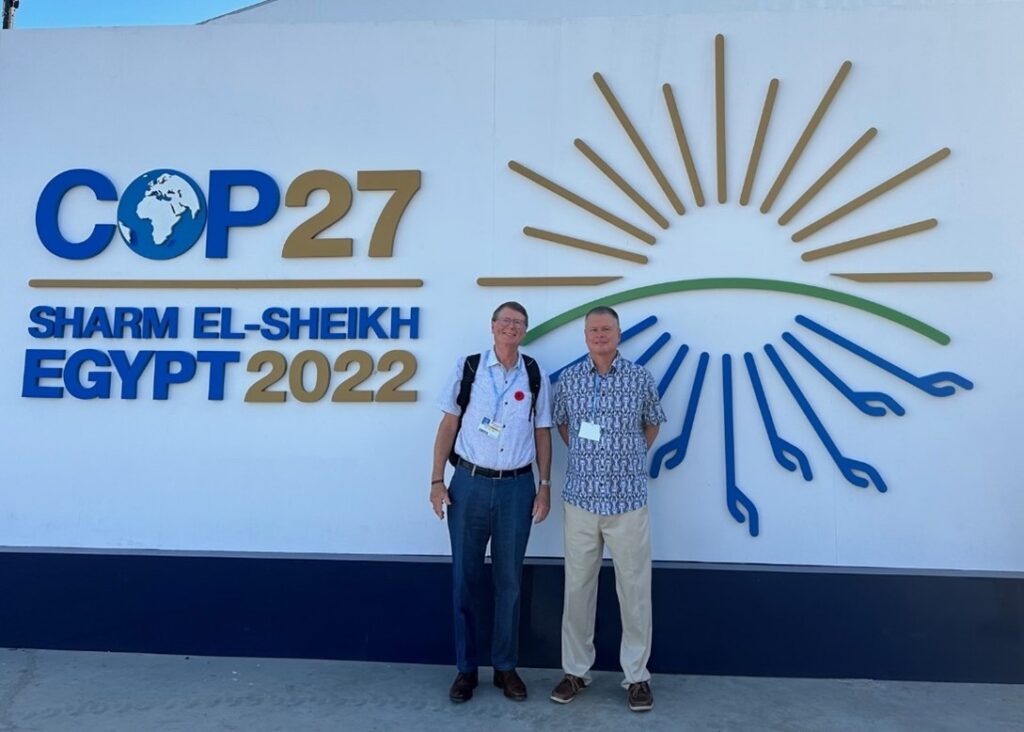
By Stuart Wason, FCIA
Have you ever wondered what happens at the Conference of the Parties (COP), the United Nations’ annual climate change summit? I was asked by the International Actuarial Association (IAA) to attend COP27 in Egypt in November 2022. Here’s what I learned.
Every year since 1995, the UN has hosted a COP, which brings together leaders from around the globe to address human-related climate issues. The 2021 COP26 in Scotland saw progress in a number of areas, including the presentation of a major scientific assessment by the Intergovernmental Panel on Climate Change (IPCC), agreements to phase out some fossil fuel subsidies, a framework for carbon trading, and commitments on deforestation and methane emissions. However, much was left to be done, including making specific commitments on fossil fuel investments and funding for adaptation efforts in developing countries. COP27 was billed as a move from planning to action on specific activities to address climate change. It was to have been the “implementation COP.”
There were 45,000 participants at this year’s COP, consisting of delegates from each Party (i.e., country) to the UN Framework Convention on Climate Change as well as tens of thousands of observers from non-governmental organizations such as the IAA. Within the controlled entry “Blue Zone” (accessible only to pre-registered delegates and observers), the meetings were split between COP negotiation sessions, which were closed to observers, and an exhibit hall open to all attendees. The exhibit hall consisted of hundreds of pavilions sponsored by various countries and organizations. This is where Rade Musulin, a fellow IAA representative from Australia, and I spent our time at COP.

Together, Rade and I had many discussions introducing the actuarial profession to participants, in addition to holding meetings with several key stakeholders. Our aim was to help the profession become a more prominent player in this important emerging area of actuarial practice.
A typical day at COP
Most of the pavilions at COP were quite sizeable and included spaces to convene panel presentations for observers. The Canadian pavilion, for example, held sessions on a variety of topics every day of the two-week conference. During our week-long stay at COP, Rade and I sampled a wide variety of panels at different pavilions.
One of the sessions I attended at the Canada pavilion was entitled “Implementing a National Adaptation Strategy that Addresses Wildfire, Flood and Extreme Heat Risks that Canada Is Facing Today.” The session was led by the Insurance Bureau of Canada (IBC) for Climate Proof Canada. The speakers included Craig Stewart of IBC, ER physician Courtney Howard, a representative from the Federation of Canadian Municipalities, and Ann Howard of the International Institute of Sustainable Development. The speakers are shown in the photo below, along with Canada’s Minister of the Environment and Climate Change, Steven Guilbeault, who thanked the presenters and provided an update on Canada’s National Adaptation Plan (NAP).

Experts have identified adaptation – the process of adjustment to actual or expected climate change and its effects – as critical to mitigating climate-related risks. In speaking about adaptation, the panel made the following key points:
- Canada is close to finalizing its NAP.
- Canada’s NAP will include close cooperation and inputs from all stakeholders, including various levels of government, municipalities and groups such as Climate Proof Canada.
- Adaptation requires good governance at all levels.
- Understanding of adaptation is still low and better public education and communication is needed.
- The uncertainty surrounding adaptation is huge and will therefore require nimble decision-making.
- Adaptation brings together a variety of short- and longer-term time horizons.
- Everyone is curious about adaptation, but few are making it a priority.
- Governance of adaptation requires clear establishment of “who is in charge,” as there are many actors in making change.
- Adaptation requires vertical integration of decision-making (e.g., at the municipal, provincial and federal levels). This can be especially difficult as different levels of government may not be similarly informed and engaged on the topic of climate adaptation.
- Adaptation requires clear accountability and hence targets that are measurable and perhaps stated in terms of desired outcomes.
- Progress needs to be tracked and reported. This can be done by the private sector or through the government.
- Municipalities need ongoing stability in funding so that key infrastructure is maintained and upgraded to meet the effects of climate change. They must also continue to plan and allow space for parks and green areas to help mitigate climate change impacts.
Additional observations from COP27 include:
Global activity is enormous
COP27 helped us understand the breadth of efforts in climate change and sustainability. In addition to the “usual suspects” of climate science and financial reporting (e.g., the International Sustainability Standards Board), we saw significant activity in agriculture, food security, blue carbon, adaptation and greenhouse gas mitigation. This will help us further contribute to IAA (and member actuarial association) activities in the coming year. It is also clear that almost every economic activity will be impacted by climate risk and decarbonization, underscoring the importance of climate-related risk to our profession.
Beyond the news
There’s much more going on at these meetings than one sees on the news, which tends to focus on major government agreements (or lack thereof). Being physically present allowed us to see presentations on new technologies, adaptation strategies, mitigation measures and other innovations and projects that don’t necessarily make the news. At the conference, it became clear that there’s far more going on than government agreements, and this is a cause for hope.
1.5°C is not achievable
Despite it being an almost sacrosanct goal in the eight years since the Paris Climate Agreement was signed, scientific presentations made it clear that there is almost no realistic path to limiting warming to 1.5°C (a reality outlined in The Economist in an excellent article on the subject). On the other hand, it is also becoming clear that we are unlikely to see the most extreme scenarios. Thus, the range of likely outcomes is narrowing as scientific understanding improves.
As an example of the richness of presentations at COP, we saw very good sessions on high-latitude (mostly Arctic) permafrost loss and its effect on methane levels. Such information will be very helpful in constructing realistic scenarios, the subject of several papers by the IAA’s Climate Risk Task Force.
Adaptation is key
The high likelihood of warming at levels above 1.5°C makes a powerful case for adaptation. We saw several very good sessions on vulnerable populations and the challenges with measuring risk and adaptation potential in developing countries. While adaptation is important for all parts of the globe, vulnerable populations may benefit the most from these efforts. The IAA previously produced a paper on vulnerable populations, Climate Change, Insurance and Vulnerable Populations, which we noted in some discussions.
Beyond climate to sustainability
There was a great deal of attention being paid to food security, water resources, biodiversity, plastics pollution and other related topics. This shows an evolution in thinking about climate risk to include broader sustainability issues. COP discussions also stressed the importance of a just transition, the needs of vulnerable populations and other social dimensions of climate change.
In-person presence allowed for key meetings
In addition to allowing us to interact with a wide range of experts and introduce attendees to the profession, our presence at COP offered a valuable opportunity to hold face-to-face meetings with several key stakeholders, including the Intergovernmental Panel on Climate Change (IPCC), the International Sustainability Standards Board (ISSB), the UK’s Financial Conduct Authority (FCA), the United Nations Development Programme (UNDP) and the United Nations Environment Programme (UNEP).
We were able to discuss directly with IPCC’s Working Group II a potential collaboration with the IAA on a joint report related to adaptation. We also met with members of the ISSB, including its vice-chair, and set the stage for future discussions about their new standards.
Where do we go next?
Rade and I were both somewhat surprised that, beyond the two of us, we were able to identify just one other actuary in attendance, from South Africa. We also noted that apart from the presence of one or two insurers, as well as Canada’s IBC, there seemed little other participation from the global insurance sector.
We believe the profession has an important role to play in helping key stakeholders in the management of their climate-related risks. It’s also our view that the profession should build toward a broader and more defined approach to sustainability topics such as food security (which has obvious links to actuarial work in many countries).
This article reflects the opinion of the author and does not represent an official statement of the CIA.





